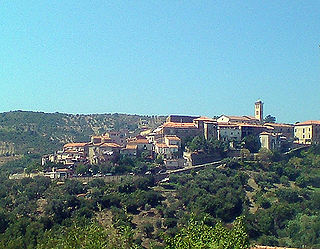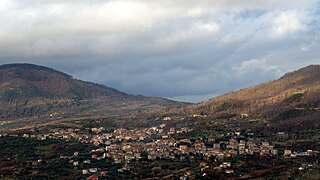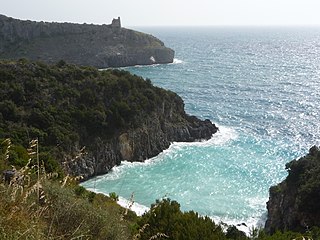
Campora is a town and comune in the province of Salerno, Campania. It is located in the territory of Cilento and as of 2009 its population was 810.

Agropoli is a town and comune located in the Cilento area of the province of Salerno, Campania, Italy. It is situated at the start of the Cilentan Coast, on the Tyrrhenian Sea.

Capaccio Paestum is a town and comune in the province of Salerno in the Campania region of south-western Italy. The ruins of the ancient city of Paestum lie within borders of the comune.

Casal Velino, also spelled Casalvelino, is a town and comune in the province of Salerno in the Campania region of south-western Italy.

Castellabate is a town and comune in the province of Salerno in the Campania region of south-western Italy.

Castelnuovo Cilento is a town and comune in the province of Salerno in the Campania region of south-western Italy.

Gioi is a town and comune in the province of Salerno in the Campania region of south-western Italy. As of 2011 its population was of 1,339.

Giungano is a town and comune in the province of Salerno in the Campania region of south-western Italy.

Laureana Cilento is a town and comune in the province of Salerno in the Campania region of south-western Italy.

Lustra is a town and comune in the province of Salerno, in the Campania region of south-western Italy.

Moio della Civitella is a town and comune in the province of Salerno in the Campania region of south-western Italy.

Ogliastro Cilento is a town and comune in the province of Salerno in the Campania region of south-western Italy. As of 2011 its population was of 2,241.

Prignano Cilento is a town and comune in the province of Salerno in the Campania region of south-western Italy. As of 2017 its population was of 1,035.

Valle dell'Angelo is a town and comune in the province of Salerno in the Campania region of south-western Italy.
The name translates as "Valley of the Angel" and the comune contains La Grotta dell'Angelo. The cave safeguards the statue of the Archangel Michael, shown in defensive posture.

Vallo della Lucania is a town and comune in the province of Salerno in the Campania region of south-western Italy. It lies in the middle of Cilento and its population is 8,680.

Torchiara is a town and comune in the province of Salerno in the Campania region of south-western Italy.

Santa Barbara is an Italian village and hamlet (frazione) of the commune of Ceraso in the Province of Salerno, Campania. It has a population of roughly a thousand.

Cilento is an Italian geographical region of Campania in the central and southern part of the Province of Salerno and an important tourist area of southern Italy.

The Parco Nazionale del Cilento, Vallo di Diano e Alburni is an Italian national park in the Province of Salerno, in Campania in southern Italy. It includes much of the Cilento, the Vallo di Diano and the Monti Alburni. It was founded in 1991, and was formerly known as the Parco Nazionale del Cilento e Vallo di Diano.

The strada statale 18 "Tirrena Inferiore" is an Italian state road, connecting Campania and Calabria.























